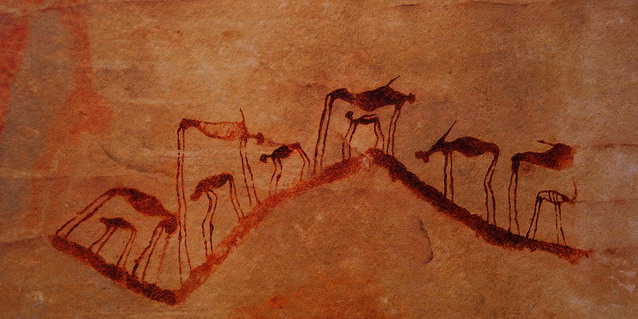Rock Art
Many thousands of years ago, the ancestors of modern Africans created rock art—pictures on boulders, cliffs, and the walls of rock shelters. Carved rock art images are known as petroglyphs, while painted ones are pictographs. These rock pictures offer haunting glimpses of the lives of people long vanished. Some images also show an ancient environment very different from that of modern Africa.

Southern Africa
Some of the oldest rock art—often made on small, portable stones—comes from southern Africa. In a rock shelter in NAMIBIA, six portable painted stones were found in a layer of deposits estimated to date from around 26,000 years ago. Stones with petroglyphs created between 4,000 and 10,000 years ago were discovered in SOUTH AFRICA. People have found similar examples of portable rock art in caves along the South African coast. Most pieces are about 2,000 years old. After that time people appear to have stopped making portable rock art, working instead on fixed rock surfaces.
The ancient people who created most of the rock art in southern Africa probably had beliefs and rituals similar to those of the people who inhabit the KALAHARI DESERT today. Their artwork shows people performing a dance with the same postures and gestures used in the trance dance, a central ritual of Kalahari people. Rock art also features many images of eland, a kind of antelope that the people of the Kalahari believe to be magical. These pictures establish a link between past and present cultures. They also indicate that the rock art of southern Africa was more than a pastime or even a historical record. It was an expression of religious and magical beliefs.
Eastern Africa
Most of the rock art in eastern Africa is found in central TANZANIA. The most common images are pictographs related to hunting, including realistic illustrations of wild animals such as giraffe, eland, and elephants. Painted in shades of red, the animals are sometimes running away, lying on the ground, or shown with lines drawn from their mouths, which may indicate bleeding. Human figures are also shown, sometimes dancing or holding bows. The age of this work is unknown, but it may be 20,000 years old.
More recent rock art from Tanzania consists of human and animal forms, especially giraffes and lizards, drawn in thick white paint. Some works also feature handprints, spirals, circles and rays, and other symbols. This art may have been associated with ancient rituals. Even today, certain rock art sites are used for magical or spiritual ceremonies.
Rock art in ERITREA, ETHIOPIA, and SOMALIA shows more cattle than wild animals, suggesting that the artists who created it were herders. Circles, spirals, and other geometric patterns found with these images and in western Kenya resemble designs that people of the region today use as cattle brands. The oldest cattle images may date from several thousand years ago, but some rock art around Lake Victoria and other eastern lakes is much more recent. One image shows a canoe with a type of sail that was unknown in the area until the 1800s.
Northern Africa
Northern Africa is especially rich in rock art, with more than 30,000 paintings and carvings discovered in the SAHARA DESERT alone. These pictures reveal dramatic changes in the environment and culture of the area over the past 10,000 years.
The oldest images are petroglyphs made after about 8000 B.C. Like the rock art of central Tanzania, they represent the world of the hunter. Hippopotamus, giraffe, buffalo, ostrich, elephant, and antelope are portrayed realistically—sometimes life-sized—on the rock walls of valleys. Human figures are much smaller and less realistic. They may hold axes, clubs, or bows, and they sometimes carry animal masks. All of these images reflect the Sahara when it was an immense savanna dotted with lakes, not the desert it is today.
The first Saharan pictographs date from around 6000 B.C. and are found at Tassili n'Ajjer, a site in ALGERIA. Most of the paintings show groups of human figures with round heads that may represent ceremonial masks. They were drawn with ochre (a reddish or yellowish clay) mixed with a protein-filled liquid, such as milk or blood.
Later pictographs at Tassili n'Ajjer show the cultural changes that occurred as the Sahara region gradually became drier. As game grew scarce, pastoralist groups replaced hunters. They painted images of humans and cattle, showing people in everyday activities, such as tending herds and talking. Details such as hairstyles and clothing are clear, and the use of different colors suggests that both light-skinned and dark-skinned people lived in this herding culture. The rock art made after 1200 B.C. contains many images of horses and chariots, introduced by newcomers to the region. More recent images from the past 2,000 years show the desert environment and feature pictures of camels. Rock carvings have also been found in North Africa, high in the Atlas Mountains of Morocco. These petroglyphs feature abstract and geometric designs and pictures of weapons. They appear to be the work of a Mediterranean culture that left no traces elsewhere in Africa. (See also Archaeology and Prehistory, Art, History of Africa.)